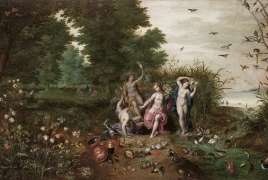“Brueghel: Masterpieces of Flemish Art” exhibit opens in Bologna October 2, 2015 - 13:29 AMT PanARMENIAN.Net - After the widespread, stunning success of the first exhibition dedicated to the Dutch genius Escher, visited by more than 175,000 people, Arthemisia Group is continuing its work in the rooms of the Palazzo Albergati with a new project devoted to art, this time Flemish: the exhibition Brueghel, Art Daily reports. Masterpieces of Flemish Art, which traces back over history along a temporal, familial and pictorial horizon spanning more than 150 years, bringing to Bologna the masterpieces of an entire dynasty of exceptional talent active between the 16th and 17th centuries. Brueghel, the name of a family that in centuries past became a mark of excellence in the pictorial arts and included the most important group of Flemish artists working between the 16th and 17th centuries, interpreters of the splendour of the 17th century. The family that amazed the world with paintings that have come down to us thanks to their tremendous value, appreciated since the 17th century, is taking centre stage at the Palazzo Albergati with works by Pieter Brueghel the Elder, The Resurrection (c.1563); Pieter Brueghel the Younger, Outdoor Wedding Dance (c.1610); Jan Brueghel the Elder, River Landscape with Bathers (1595 - 1600); Jan Brueghel the Younger, Travellers at a Meeting Point (c.1630); Abraham Brueghel, Large Still Life with Fruit in a Landscape (1670) and Ambrosius Brueghel, Still Life with Flowers (1660 - 1665) in an exhibition that analyses the realist revolution in European painting that emerged from the genius of the Brueghel family, which influenced, through the gaze of its inventive members, the great themes of the history of western art. The exhibition aspires to take visitors on a passionate journey to the golden age of 17th-century Flemish painting, in search of the visionary genius of five generations of artists who chorally embodied - as no one else before or since - the style and trends of more than a century of art history. While the Italian Renaissance concentrated attention on the noble and virtuous ideal of the human figure, elevating its greatness and virtue through the work of Michelangelo, Leonardo and Titian, in Flanders the perspective was radically different. Pieter Brueghel the Elder, the head of the family and deeply familiar with and appreciative of Italian painting, was dedicated to the everyday reality of human life, investigating all of its aspects without excluding the more crude and realistic ones, lingering over the darker side and vices of peasants and merchants and the toil of life as well as the often coarse and vulgar gaiety of ordinary people, as in the Outdoor Wedding Dance (c.1610) by Pieter Brueghel the Younger. An eye focused ruthlessly on life as it was really lived, on works of charity, but also on the weaknesses and everyday suffering concerning one and all, as in, for example, the Seven Acts of Mercy (1616 - c.1618) by Pieter Brueghel the Younger. And while in the Italian Renaissance nature was limited to being a background for the magnificent plastic and aesthetic superiority of humankind, in Flemish painting - in the style of Brueghel - the role of Nature was fully that of a protagonist in human history and it was represented with visual richness, attention to detail and a compositional beauty never before seen in the history of painting, examples being the meticulous, detailed Large Still Life with Fruit in a Landscape (1670) by Abraham Brueghel and the charming Allegory of the Four Elements (1630 - 1635) by Jan Brueghel the Younger and Hendrick van Balen. A strong, vigorous Nature that dominated humankind, which was often submissive before its power. Pieter Brueghel the Elder, and after him his rich progeny, invented a pictorial code that quickly became a distinguishing mark, a kind of brand of the family, which starting in the middle of the 16th century continued its activity for more than two centuries. Also on view is an important selection of artists - from Frans de Momper and Frans Francken to Hendrick van Balen and Joos de Momper and many others who contributed to creating one of the richest chapters in the history of art - together with members of the Brueghel family, true masters of detail and specialists in painting animals, flowers and objects. Photo: Art Daily The creative crew of the Public TV had chosen 13-year-old Malena as a participant of this year's contest. She called on others to also suspend their accounts over the companies’ failure to tackle hate speech. Penderecki was known for his film scores, including for William Friedkin’s “The Exorcist”, Stanley Kubrick’s “The Shining”. The festival made the news public on March 19, saying that “several options are considered in order to preserve its running” Partner news |